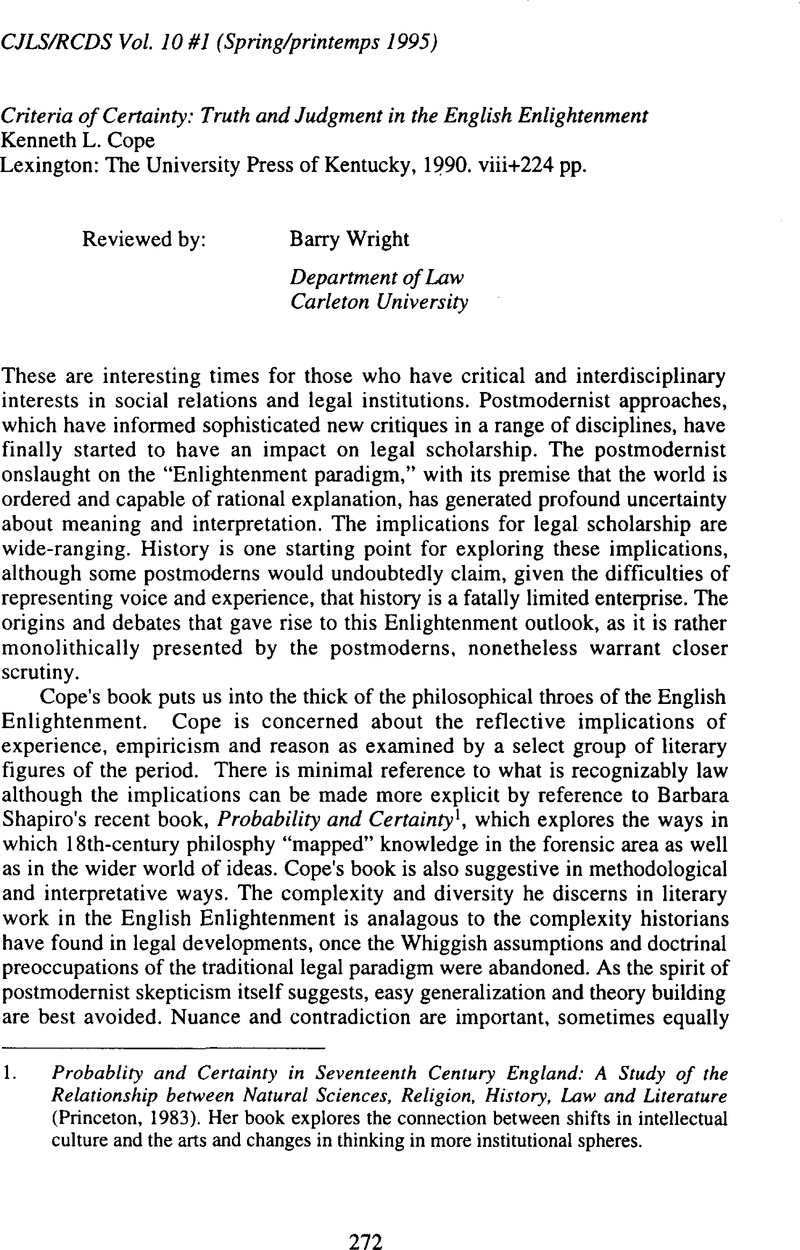No CrossRef data available.
Article contents
Criteria of Certainty: Truth and Judgment in the English EnlightenmentKenneth L. Cope Lexington: The University Press of Kentucky, 1990. viii+224 pp.
Published online by Cambridge University Press: 18 July 2014
Abstract

- Type
- Reviews/Recensions
- Information
- Canadian Journal of Law and Society / La Revue Canadienne Droit et Société , Volume 10 , Issue 1 , Spring/printemps 1995 , pp. 272 - 277
- Copyright
- Copyright © Canadian Law and Society Association 1995
References
1. Probablity and Certainty in Seventeenth Century England: A Study of the Relationship between Natural Sciences, Religion, History, Law and Literature (Princeton, 1983)Google Scholar. Her book explores the connection between shifts in intellectual culture and the arts and changes in thinking in more institutional spheres.
2. Halifax, for instance, stresses the variable, unstable character of evidence (p. 46). The applicability of generalizing laws to any one situation is dependably doubtful and knowledge is uncertain (p. 55). Dryden rejects arbitrary power and celebrates an early version of the rule of law (p. 78). Rochester was far more interested in sex than law.
3. See, for instance, Peller, Gary, “The Metaphysic of American Law” (1985) 73 California L. Rev. 1152CrossRefGoogle Scholar.
4. Foucault, M., The History of Sexuality: An Introduction, vol. 1 (New York: Vintage, 1990) at 150, 156Google Scholar.
5. In the Canadian context, the legal dimensions of production/reproductive connection is examined by scholars such as Ursell in her examination of labour policies and women workers: Ursell, J., “The State and the Maintenance of Patriarchy: A Case Study of Family, Labour and Welfare Legislation in Canada” in Dickinson, J. and Russell, B., eds., Family, Economy and the State: The Social Reproduction Process Under Capitalism (Toronto, 1986)Google Scholar. See, also, Chunn, D., From Punishment to Doing Good: Family Courts and Socialized Justice in Ontario, 1880-1940 (Toronto, 1992)Google Scholar.
6. Foucault, supra note 4 at 160, suggests that we must not think that by saying yes to sex, one says no to power.
7. Some other examples: “Halifax's nation may be a ‘Mass of Dough,’ but Locke's is a cake mix that comes out perfect every time”(p. 111); “Explaining the whole universe through one's own benevolent behaviour is a tall order, one calling for more than a phone booth in which to don the cape, leotard and boots” (p. 160); “Truncated by a satirical adversary who orders ‘more essays on Man’ as if they were junk food…” (p. 165); “Smith's historicism however, is not the dead-end street in the ghost town of ideology… Were Smith a cocktail lounge singer, then ‘Feelings,’ that anthem of conventionalised spontaneous sentiment, would be his opening number.” (p. 175); “A natural, easy and commonsensical understanding of the world represents so total a transformation of experience that it makes both isolated innovator and establishment researcher seem like grubby naturalists.” (p. 179); “To imagine that the average sad sack thinks of himself as a self-sacrificing system, is, to say the least, to think a fiction.” (p. 187).
8. Beattie, J. M., “Scales of Justice: Defence Counsel and the English Criminal Trial in the Eighteenth and Nineteenth Centuries” (1991) 9 Law and History Review 221CrossRefGoogle Scholar.




